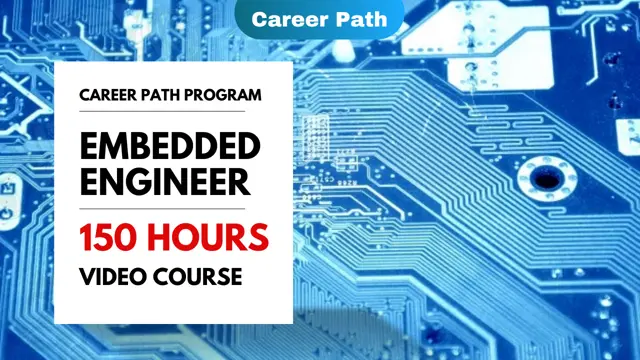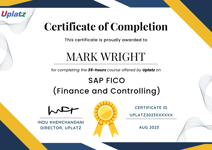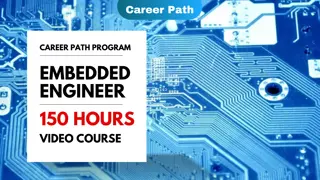
Embedded Engineer Career Path
Self-paced videos, Lifetime access, Study material, Certification prep, Technical support, Course Completion Certificate
Uplatz
Summary
- Uplatz Certificate of Completion - Free
Add to basket or enquire
Overview
Uplatz offers this comprehensive Career Path program on Embedded Engineer. It is a self-paced program consisting of video courses leading to acquisition of skills for a successful career as Embedded Engineer. You will be awarded Course Completion Certificate at the end of the course.
Courses included in Embedded Engineer Career Path program are:
1) Embedded Systems and MATLAB Programming
2) How to become Embedded Firmware, Software, Hardware Engineer
3) Legacy Embedded Systems
4) C and Embedded C Programming
5) Linux and Embedded Linux
6) Digital System Design with VHDL & Verilog
7) VLSI - Microcontrollers - PLC - Assembly Language
8) FPGA Design & Implementation
9) Digital Signal Processing (DSP)
10) Computer Hardware Engineering
An embedded systems engineer assists in the design, development, and maintenance of embedded systems in products. Software development is often a part of the job. However, it also requires a thorough understanding of full embedded systems. An embedded engineer works on embedded systems that have a specified mission to complete. The software that is part of the system is often developed by the engineer. The engineer may also assist with the testing of the complete system to verify that it functions properly. The work responsibilities of an embedded engineer are determined by their job title and experience. A junior embedded engineer concentrates on understanding the system's fundamentals. A main embedded engineer may contribute to the overall design and improvement of the system.
Embedded systems are a combination of hardware and software designed to provide a specific function within a larger system. Embedded systems are increasingly common in the world of the Internet of Things as more of our devices and products are connected directly to real-time monitoring. System design for interconnected products allows computing systems to safely monitor, track, and repair faster than ever possible. Computer science can now create these intricate systems within a broader framework that makes it easier to control and implement these pieces without losing overall control. The world is moving towards the ease of IoT. What used to take a ton of human power can now be accomplished by the power of machine learning and AI. Embedded system software ranges from little to no user interface to complex user experiences that more deeply connect us to the devices in our world. Consumer electronics, cars, agricultural equipment, manufacturing, and medical equipment are all possible locations for embedded software. The development process for this new era can be complex, and it's worth it to learn the types of hardware and software tools available to you.
Certificates
Uplatz Certificate of Completion
Digital certificate - Included
Course Completion Certificate by Uplatz
Course media
Description
Manufacturers are embedding software into automobiles, homes, appliances, and other things that consumers use on a regular basis as technology advances and becomes more complicated. These embedded systems may operate anything from a basic digital calculator to a large industrial robot or guided missile. Consumer electronics, aerospace, medical research, and the automobile industry are all good places to work as an embedded developer or embedded engineer. The primary goal of an embedded engineer is to operate and/or manage a physical device. As a result, it has been tuned to satisfy the unique requirements of embedded systems, all for the advantage of the user. Embedded software programmers do not code for PCs, even if they work on them; their software runs on other platforms (e.g., an electronic board with a microcontroller). Embedded engineers, for example, flash their binary executable files on an electrical circuit board. They do this via the use of debugging tools or specialized ports.
From entry level until retirement, the embedded Engineer job path provides several alternatives. Starting your career as a junior embedded developer, for example, gives you the option to advance to senior embedded engineer. You must, however, put forth the effort. An embedded engineer, like a doctor or a lawyer, must keep current with their specialty in order to be informed about the newest innovations in the market.
Course Objectives
- Understand embedded systems and embedded engineering
- Learn about the legacy embedded systems and the paradigm shift in this sector
- Using MATLAB create and build embedded software (or another programming language)
- For developing code, you should be familiar with peripherals, compilers, vision control, and text editors.
- To convert code, libraries, debuggers, and simulators, you'll need to know how to use assemblers.
- Understand electronics schematics and embedded hardware systems.
- Communicate and solve problems
Who is this course for?
The target audience for an Embedded Engineer career path programme is typically individuals who are interested in pursuing a career in embedded systems engineering or related fields. This may include recent graduates or professionals who are looking to gain specialized knowledge and skills in embedded systems design, development, and testing, and are interested in pursuing a career as an Embedded Engineer.
In addition, the programme may be suitable for individuals who are currently working in the engineering or IT field, but are looking to specialize in embedded systems engineering or take on more senior roles in their organizations. The programme may also be relevant for individuals who are interested in starting their own engineering business, as it provides a strong foundation in embedded systems design, microcontroller programming, and system integration.
The Embedded Engineer career path programme is designed to provide a comprehensive education in embedded systems engineering, including hardware and software design, programming, and testing, and is suitable for individuals who are interested in pursuing a career in embedded systems engineering or related fields. The programme may require some prior knowledge of engineering or programming concepts, but may also include introductory courses for individuals who are new to the field.
Requirements
Passion and determination to learn and succeed!
Career path
- Embedded Engineer
- Software/Hardware Engineer
- Design Engineer
- Firmware Engineer
- Electronics Engineer
- FPGA Design Engineer
- Microcontroller Design Engineer
- Verilog & VHDL Design Engineer
Questions and answers
Currently there are no Q&As for this course. Be the first to ask a question.
Reviews
Currently there are no reviews for this course. Be the first to leave a review.
Legal information
This course is advertised on reed.co.uk by the Course Provider, whose terms and conditions apply. Purchases are made directly from the Course Provider, and as such, content and materials are supplied by the Course Provider directly. Reed is acting as agent and not reseller in relation to this course. Reed's only responsibility is to facilitate your payment for the course. It is your responsibility to review and agree to the Course Provider's terms and conditions and satisfy yourself as to the suitability of the course you intend to purchase. Reed will not have any responsibility for the content of the course and/or associated materials.



